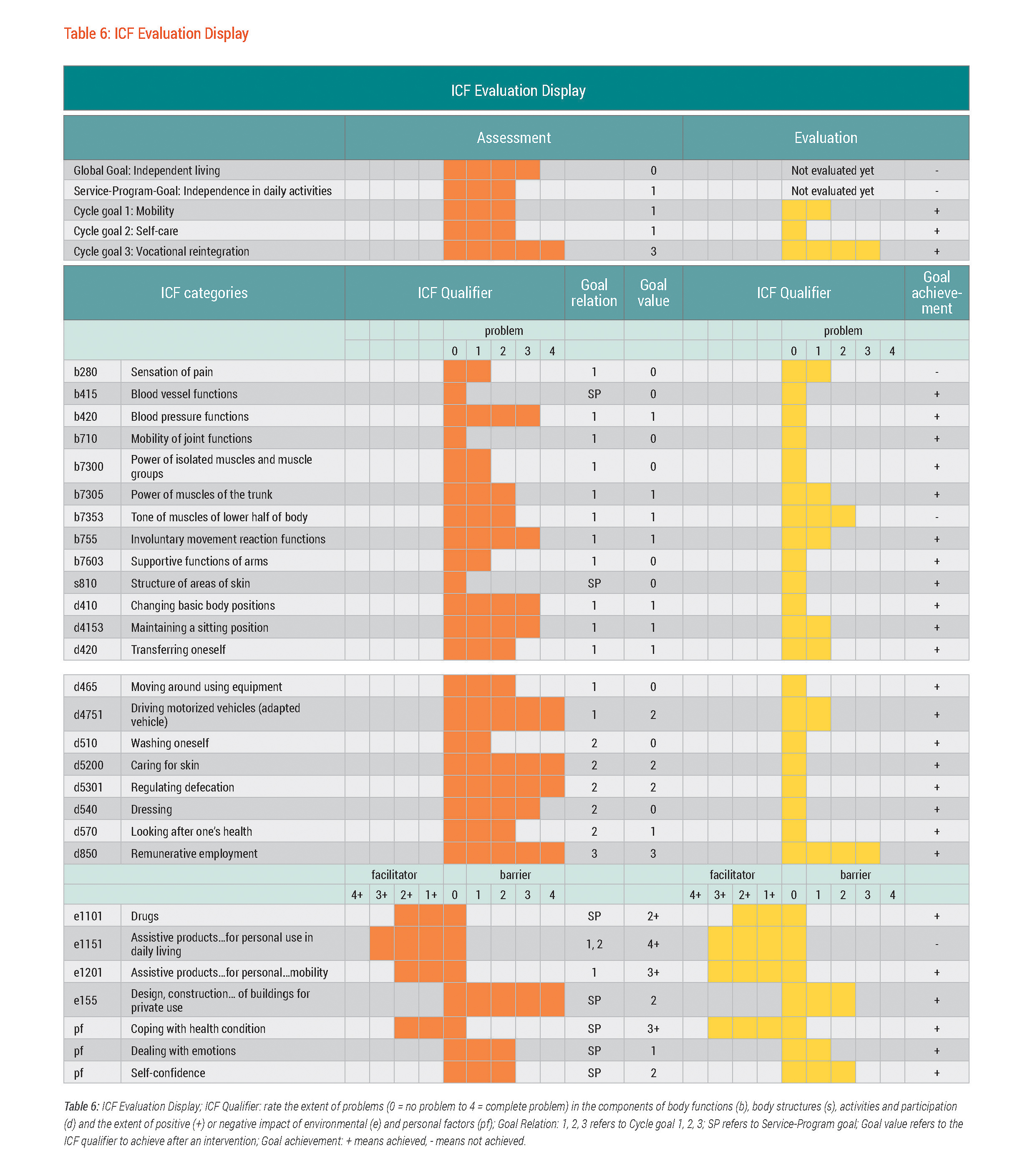Evaluation
The outcome of the evaluation of each intervention target including goal achievement is illustrated in table 6, the ICF Evaluation Display. The ICF Evaluation Display is a visual depiction of the change between Martin's functioning status before and after intervention. It is important to note however that this "before-after" picture of change does not necessarily signify that the change is due to the intervention itself, but only that there was some sort of change.
Small Steps Toward Vocational Reintegration
In Martin's case, it seemed that vocational rehabilitation (VR) counselling was successful in building the trust between Martin and his VR counsellor, as attested by Martin's willingness to complete the computer course (including word processing and creating spreadsheets) that the counsellor recommended despite his lack of enthusiasm for computer work. In addition, VR counselling and training was successful in promoting Martin's initiative-taking and in strengthening his self-confidence and decision-making skills. It was ultimately Martin's decision to continue attending the computer courses until completion. Moreover, in the computer courses he demonstrated his ability to work independently and effectively.
With regard to initiative-taking, Martin made his own suggestion for a course to take – he wanted to enrol in a course for English as a foreign language. The VR counsellor found this to be a very positive development given Martin’s prior indecisiveness. It also demonstrated that the process of defining potential vocational direction and possible options was under way.
Surprisingly Martin asked to learn English...This shows me that he has now become active...and this is the starting point for any clarification of vocational options.
Martin's VR counsellor
Accordingly, Martin's ICF Evaluation Display shows that the moderate goal he and his rehabilitation team had set for the intervention target of ‘remunerative employment’ was achieved, that is, an improvement from complete to severe problem. Considering this moderate achievement, there was room for further improvement in a subsequent Rehab-Cycle®. The VR counsellor decided to proceed with the clarification and decision phase of VR in a new Rehab-Cycle® to start after this Rehab-Cycle® has finished.

Table 6: ICF Evaluation Display; ICF Qualifier: rate the extent of problems (0 = no problem to 4 = complete problem) in the components of body functions (b), body structures (s), activities and participation (d) and the extent of positive (+) or negative impact of environmental (e) and personal factors (pf); Goal Relation: 1, 2, 3 refers to Cycle goal 1, 2, 3; SP refers to Service-Program goal; Goal value refers to the ICF qualifier to achieve after an intervention; Goal achievement: + means achieved, - means not achieved.
Big Step Toward Independent Living
Regarding Martin's overall functioning, the rehabilitation team was pleased to find that he had made excellent progress. After four months of rehabilitation, he was completely independent in executing activities of daily living and self-care including bowel and bladder management. From the perspective of his rehabilitation team, Martin was ready to be discharged from the rehabilitation centre.
""After four months of rehabilitation, he was completely independent in executing activities of daily living and self-care...""
However, some challenges for Martin remained.
A number of impairments in body functions and structures persisted. While Martin’s leg pain was under control, pain that he was experiencing at the base of the spine was increasing in intensity and was not yet manageable. Muscle spasticity continued to be a problem. Unfortunately, neither sauna therapy nor hippotherapy was able to relieve Martin of the spasticity. Another outstanding issue was recurring urinary tract infections, despite continuous medical treatment.
In spite of these persistent health complications, Martin succeeded in achieving all of his cycle goals, leaving him and his rehabilitation team optimistic about Martin's future.
""...Martin succeeded in achieving all of his cycle goals, leaving him and his rehabilitation team optimistic about Martin's future.""
During the course of rehabilitation, Martin’s spinal cord independence measure (SCIM) score21 steadily increased from 8 to 70 out of 100. The higher the score, the more independent a person is. See table 1. Although the biggest improvement in independence occurred in self-care and sphincter management (bladder and bowel), Martin's SCIM score also showed advances in mobility.
The psychologist who supported Martin primarily in addressing the personal factor-related intervention targets also provided input for the final evaluation in the current Rehab-Cycle®.
Martin is dealing quite well with his situation and really shows interest in his well-being and his future. He is sensitive and very open about his emotions – a very positive trait. Taking Martin’s behaviour into account, I think he’ll have no trouble achieving his goals.
Martin’s psychologist
Martin's VR counsellor added:
Initially Martin had difficulties with making decisions and commitments, and we really had to push him to participate in the computer course. He then did extremely well and thrived in the face of the challenges he faced.